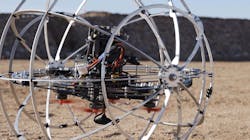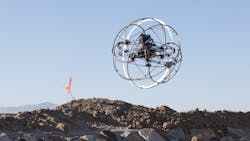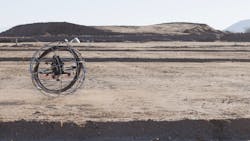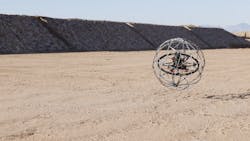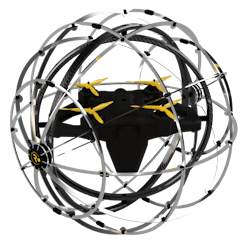New robot can switch between flying and driving
By Ariana Hurtado, Editor and Director of Special Reports
SCOTTSDALE, Arizona — Revolute Robotics, founded in 2021, recently introduced its Hybrid Mobility Robot (HMR), a drone mounted inside a spherical exoskeleton with a mechanism that allows the drone to roll on the ground when flying isn’t required.
The company said the technology combines aerial mobility with the durability and long operating time of rovers.
Revolute has built more than two dozen prototypes in sizes ranging from 10 to 30 inches, and it was ultimately determined that the 20-inch diameter worked best for carrying large batteries while still fitting through most openings. The HMR was designed to be payload-agnostic, with the ability to swap between a high-resolution camera, LiDAR scanner, infrared, thermal and NDT technology, explained CEO and Founder Collin Taylor.
The HMR can roll five times longer than it can fly, and the company’s testing suggests it can achieve 10 to 20 times longer operation when rolling.
“Drone and rover advancements have made remote inspection a reality, but the complexity of each inspection requires teams to deploy multiple robotic solutions (drones, rovers, crawlers, PIGs) depending on the need,” Taylor told Offshore. “Our hybrid aerial and terrestrial capability allows for a single solution to cover multiple uses, like the Swiss army knife of robotic inspections. One system instead of several is not only cheaper but easier to understand and implement.”
For example, the HMR offers operators of normally unmanned offshore facilities a robotic technology that can travel anywhere on the rig at any time. “In case of emergencies, it will be able to quickly travel anywhere on the rig to get a holistic view of the situation,” Taylor added.
While the technology has not started field trials, the company is currently in testing with alpha users with an international patent pending. Plus, Revolute Robotics has received interest in inspecting Shell's deepwater Gulf of Mexico assets.
The drone’s main use case is for visual inspection of confined spaces, such as tanks, fluid catalytic cracking units, offshore rigs, underground utilities, wastewater facilities, nuclear reactors, rotary kilns and pipe interiors. The technology also can be used for crack/corrosion inspection, recording valve measurement, and spill detection and response.
“Caged drones are a great solution for small, confined spaces, but they are limited by low operating times,” Taylor explained. “Like a caged drone, our robot can safely fly in confined spaces. Unlike a caged drone, our solution conserves energy by rolling on the ground: opening up larger assets and areas to the benefits of remote inspection; and enabling faster inspections due to less time spent exiting, battery swapping and reentering the asset.”
Additionally, he presented the challenges of rover-based robotics and noted the simplicity of the HMR drone’s ability to fly around potential obstacles.
“Rovers are limited by their mobility in challenging environments. Uneven terrain, slopes, gaps in the flooring and a host of obstacles prevent and/or restrict their movement,” Taylor said. “Only a few solutions are capable of climbing stairs, and the ones that can are cumbersome. No rovers that we know of can climb ladders or collect data at height. If our solution reaches an obstacle, it simply flies around it."
Additional development work
For now, Taylor said the “goal is to begin with visual inspections to gain early traction and identify standout use cases.” He added that the company intends to incorporate thermal/IR sensors, LiDAR scanners and gas detectors next and also has plans for a remote charging station for fully autonomous operations.
In addition, Taylor said the company will look into solar and wind farm applications to provide thermal inspections as well as inspections to check for cracks, peeling paint, corrosion and/or damage. Thermal inspections would remove the need for helicopters or personnel travel, and remote operation and charging allows for fully autonomous data collection to trigger maintenance if needed, he said.
Looking ahead
It recently signed on robotic experts Guinn Partners for technical development. Guinn Partners is most known for designing the Phantom 1 and Inspire 1 drones, which the company claims are the best-selling non-military drones in the world.
While the HMR is in alpha testing with several drone inspection companies, Revolute Robotics has a crowdfunding campaign on startengine.com to help bring its HMR product to life. The campaign has raised more than $73,000 as of early August and has 132 investors.
08.07.2023
About the Author
Ariana Hurtado
Editor-in-Chief
With more than a decade of copy editing, project management and journalism experience, Ariana Hurtado is a seasoned managing editor born and raised in the energy capital of the world—Houston, Texas. She currently serves as editor-in-chief of Offshore, overseeing the editorial team, its content and the brand's growth from a digital perspective.
Utilizing her editorial expertise, she manages digital media for the Offshore team. She also helps create and oversee new special industry reports and revolutionizes existing supplements, while also contributing content to Offshore's magazine, newsletters and website as a copy editor and writer.
Prior to her current role, she served as Offshore's editor and director of special reports from April 2022 to December 2024. Before joining Offshore, she served as senior managing editor of publications with Hart Energy. Prior to her nearly nine years with Hart, she worked on the copy desk as a news editor at the Houston Chronicle.
She graduated magna cum laude with a bachelor's degree in journalism from the University of Houston.
